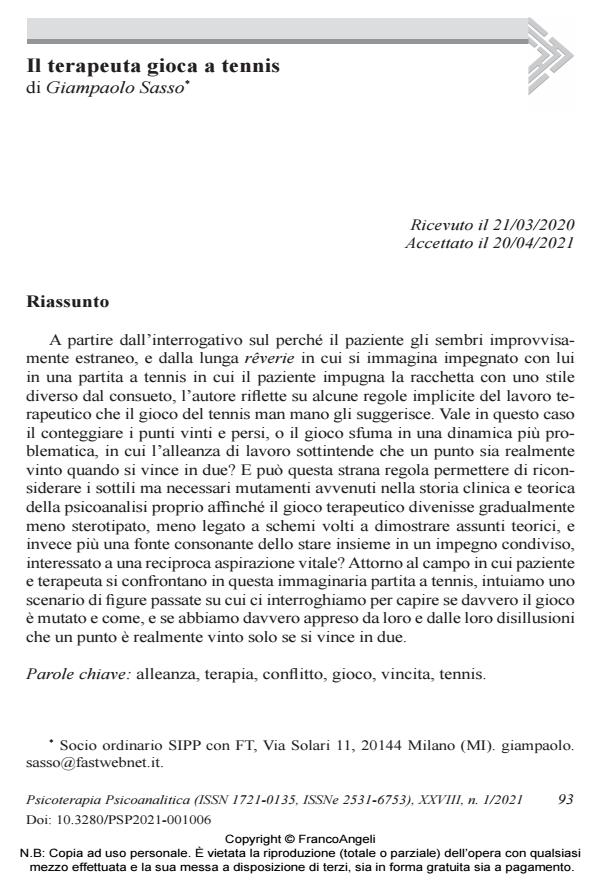Il terapeuta gioca a tennis
Titolo Rivista PSICOTERAPIA PSICOANALITICA
Autori/Curatori Giampaolo Sasso
Anno di pubblicazione 2021 Fascicolo 2021/1
Lingua Italiano Numero pagine 15 P. 93-107 Dimensione file 154 KB
DOI 10.3280/PSP2021-001006
Il DOI è il codice a barre della proprietà intellettuale: per saperne di più
clicca qui
Qui sotto puoi vedere in anteprima la prima pagina di questo articolo.
Se questo articolo ti interessa, lo puoi acquistare (e scaricare in formato pdf) seguendo le facili indicazioni per acquistare il download credit. Acquista Download Credits per scaricare questo Articolo in formato PDF

FrancoAngeli è membro della Publishers International Linking Association, Inc (PILA)associazione indipendente e non profit per facilitare (attraverso i servizi tecnologici implementati da CrossRef.org) l’accesso degli studiosi ai contenuti digitali nelle pubblicazioni professionali e scientifiche
A partire dall’interrogativo sul perché il paziente gli sembri improvvisamente estraneo, e dalla lunga rêverie in cui si immagina impegnato con lui in una partita a tennis in cui il paziente impugna la racchetta con uno stile diverso dal consueto, l’autore riflette su alcune regole implicite del lavoro terapeutico che il gioco del tennis man mano gli suggerisce. Vale in questo caso il conteggiare i punti vinti e persi, o il gioco sfuma in una dinamica più problematica, in cui l’alleanza di lavoro sottintende che un punto sia realmente vinto quando si vince in due? E può questa strana regola permettere di riconsiderare i sottili ma necessari mutamenti avvenuti nella storia clinica e teorica della psicoanalisi proprio affinché il gioco terapeutico divenisse gradualmente meno sterotipato, meno legato a schemi volti a dimostrare assunti teorici, e invece più una fonte consonante dello stare insieme in un impegno condiviso, interessato a una reciproca aspirazione vitale? Attorno al campo in cui paziente e terapeuta si confrontano in questa immaginaria partita a tennis, intuiamo uno scenario di figure passate su cui ci interroghiamo per capire se davvero il gioco è mutato e come, e se abbiamo davvero appreso da loro e dalle loro disillusioni che un punto è realmente vinto solo se si vince in due.
Parole chiave:alleanza, terapia, conflitto, gioco, vincita, tennis
Giampaolo Sasso, Il terapeuta gioca a tennis in "PSICOTERAPIA PSICOANALITICA" 1/2021, pp 93-107, DOI: 10.3280/PSP2021-001006